Drivers could be taking their foot off the gas on Barrie’s Lakeshore Drive.
Sitting in community safety committee on Oct. 4, city councillors will consider having staff investigate the feasibility of lowering the speed limit to 40 from 50 kilometres an hour on Lakeshore Drive between Tiffin to Mulcaster streets, as well as looking at other speed-control measures. Staff would then report back.
“It is being considered to reduce the chance of injury to those crossing the street, to access the beach, who often have small children in tow or are elderly and require a little more time to cross, and to encourage people to not use Lakeshore (Drive) as a short cut to downtown,” said Coun. Craig Nixon, who co-sponsored the items for discussion with Coun. Jim Harris.
“Speed and noise are the top two complaints from residents who reside along the lakeshore,” Nixon added.
The Ward 2 councillor says there's a safety difference going down to 40 km/h from 50 km/h.
“Statistics show that the fatality rate for a pedestrian being struck at 50 kilometres per hour is over 80 per cent, whereas the rate drops to 26 per cent at 40 kilometres per hour,” Nixon said.
He said these statistics were part of an Australian study by an organization called Victoria Walks, although studies by the American Automobile Association and the Ontario Ministry of Transportation show very similar numbers.
Nixon also says this portion of Lakeshore Drive has a high number of vehicles ignoring current speed limits and is used by many drivers as a shortcut to the downtown core.
“By reducing the speed limit, it is hoped that the average traffic speed will decrease,” he said.
Nixon said it can be a dangerous area.
“With parking allowed on both sides of the road, there is a large amount of people, mostly seniors and children, who are crossing the street and reducing the speed limit will result in a safer crossing,” he said. “It may also result in a reduction of engine noise from vehicles with modified mufflers where the decibel level rises along with the rate of speed.”
Peter Leon, communications co-ordinator for Barrie police, says the department does not breakdown the issuing of tickets by location.
“As for the issue of speed reduction, it is our responsibility to enforce the Highway Traffic Act and this includes speed limits,” he said. “If there are changes made to any posted or unposted speed limits anywhere in our community, we will continue to work towards ensuring our roads are safe for everyone that uses them as traffic and road safety is a shared responsibility.”
The motion also speaks to other speed-control measures, which Nixon says include photo and noise radar, along with traffic studies by Citizens on Patrol.
In August, the city announced it was getting ready to install automated speed enforcement (ASE) camera on Barrie streets, and signs in areas of Barrie where an ASE camera will be placed in a few months.
They will be posted for at least 90 days before the ASE is activated, providing drivers with advance notice.
Once the speed camera goes live, the sign will read ‘Municipal Speed Camera in Use’. Cameras will be active only when this sign is posted.
ASE is a system that uses cameras to enforce speed limits. They can reduce the risk of collisions and help ensure that motorists don’t exceed the speed limit in community safety zones — areas designated through a bylaw, passed by city council, to identify a roadway of higher risk or concern.
Certain Highway Traffic Act fines, including speeding, are doubled in community safety zones and many are located close to schools.
Barrie has 27 community safety zones identified as problem areas where the cameras could be installed. This is based on data collected showing areas where drivers are regularly exceeding the posted speed limit.
In 2017, Ontario authorized the use of ASE in municipalities to address ongoing issues with speeding in school zones and community safety zones.
On June 20, 2022, city council approved a motion to implement an ASE program in school zones and community safety zones.
A maximum budget of $300,000, funded from the tax rate stabilization reserve, is for the costs associated with the first year of implementing the program.
ASE is a system that uses a camera and a speed measuring device to detect and capture images of vehicles travelling faster than the posted speed limit in school or community safety zones. These types of charges are the responsibility of the vehicle owner and not the driver. They must currently be processed through a Provincial Offences (POA) Court office.
The ticket contains a digitized copy of the image and an enlargement of the plate portion. It is mailed to the registered licence-plate holder within 30 days of the offence, outlining next steps and the cost of the associated fine. There is a monetary fine for those convicted, but demerit points are not issued and the registered owner’s driving record isn’t affected.
For more information, visit barrie.ca/traffic.



